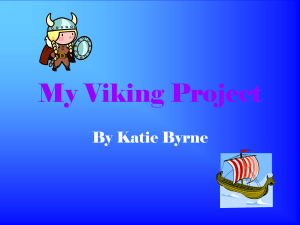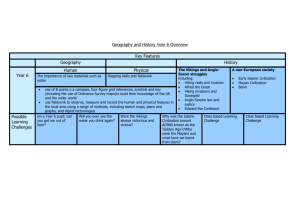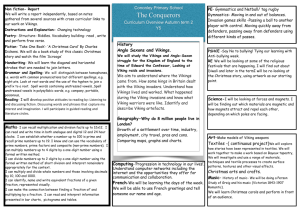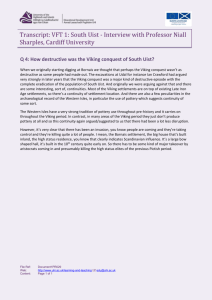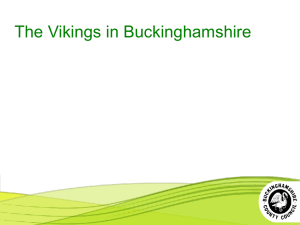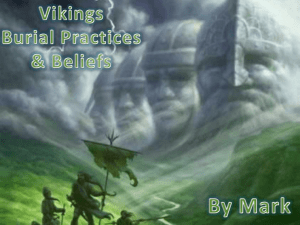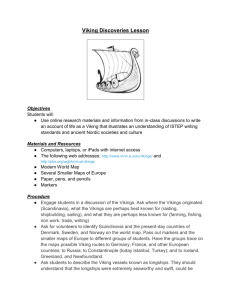The currently accepted SCA version of women`s dress
advertisement
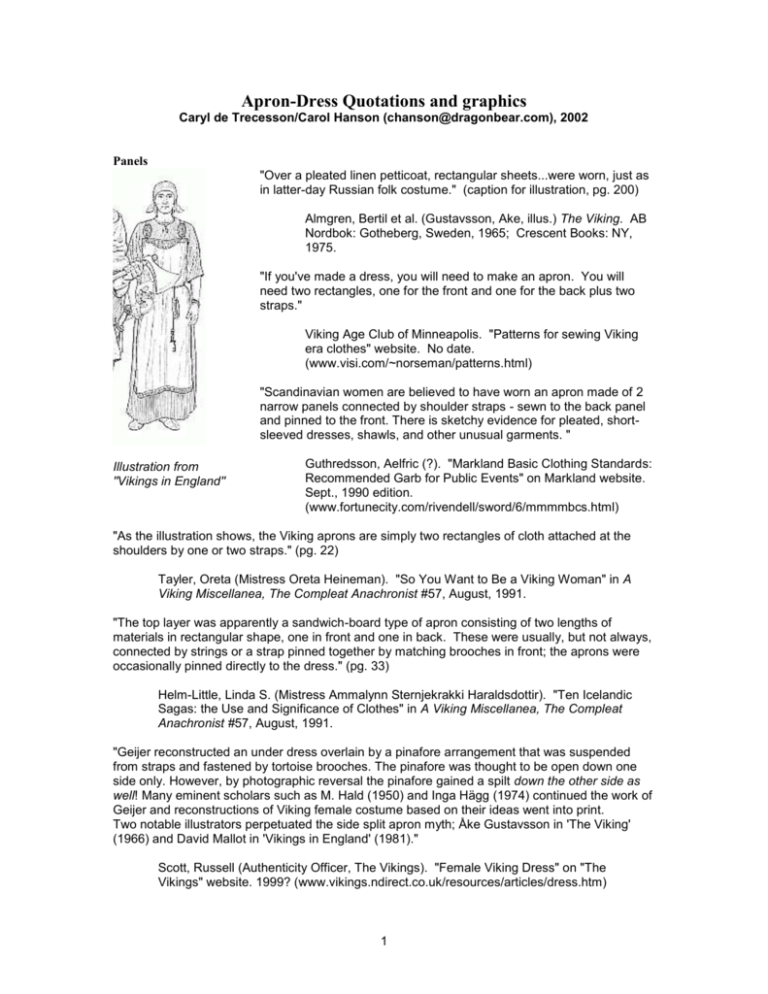
Apron-Dress Quotations and graphics Caryl de Trecesson/Carol Hanson (chanson@dragonbear.com), 2002 Panels "Over a pleated linen petticoat, rectangular sheets...were worn, just as in latter-day Russian folk costume." (caption for illustration, pg. 200) Almgren, Bertil et al. (Gustavsson, Ake, illus.) The Viking. AB Nordbok: Gotheberg, Sweden, 1965; Crescent Books: NY, 1975. "If you've made a dress, you will need to make an apron. You will need two rectangles, one for the front and one for the back plus two straps." Viking Age Club of Minneapolis. "Patterns for sewing Viking era clothes" website. No date. (www.visi.com/~norseman/patterns.html) "Scandinavian women are believed to have worn an apron made of 2 narrow panels connected by shoulder straps - sewn to the back panel and pinned to the front. There is sketchy evidence for pleated, shortsleeved dresses, shawls, and other unusual garments. " Illustration from "Vikings in England" Guthredsson, Aelfric (?). "Markland Basic Clothing Standards: Recommended Garb for Public Events" on Markland website. Sept., 1990 edition. (www.fortunecity.com/rivendell/sword/6/mmmmbcs.html) "As the illustration shows, the Viking aprons are simply two rectangles of cloth attached at the shoulders by one or two straps." (pg. 22) Tayler, Oreta (Mistress Oreta Heineman). "So You Want to Be a Viking Woman" in A Viking Miscellanea, The Compleat Anachronist #57, August, 1991. "The top layer was apparently a sandwich-board type of apron consisting of two lengths of materials in rectangular shape, one in front and one in back. These were usually, but not always, connected by strings or a strap pinned together by matching brooches in front; the aprons were occasionally pinned directly to the dress." (pg. 33) Helm-Little, Linda S. (Mistress Ammalynn Sternjekrakki Haraldsdottir). "Ten Icelandic Sagas: the Use and Significance of Clothes" in A Viking Miscellanea, The Compleat Anachronist #57, August, 1991. "Geijer reconstructed an under dress overlain by a pinafore arrangement that was suspended from straps and fastened by tortoise brooches. The pinafore was thought to be open down one side only. However, by photographic reversal the pinafore gained a spilt down the other side as well! Many eminent scholars such as M. Hald (1950) and Inga Hägg (1974) continued the work of Geijer and reconstructions of Viking female costume based on their ideas went into print. Two notable illustrators perpetuated the side split apron myth; Åke Gustavsson in 'The Viking' (1966) and David Mallot in 'Vikings in England' (1981)." Scott, Russell (Authenticity Officer, The Vikings). "Female Viking Dress" on "The Vikings" website. 1999? (www.vikings.ndirect.co.uk/resources/articles/dress.htm) 1 Wrapped "...a two-fold garment hanging from two loops...a comparison with the folk-costume of later ages suggests that this double garment was two separate lengths of cloth wrapped round the body under the armpits, one from left to right and the other from right to left." (pg. 76-77) Simpson, Jacqueline. Everyday Life in the Viking Age. B. T. Badsford: London, 1967. "As late as in the 19th century in Finnish Karelian and Ingermanland, dresses were worn by women which consisted of a rectangular piece of cloth...held up by shoulder straps. Dresses of this kind comprised two separate pieces of fabric which were worn one on top of the other so that the material of one covered the side-opening of the other, neither had seams." (pg. 365-366) Hald, Margrethe. Ancient Danish Textiles from Bogs and Burials. The National Museum of Denmark: Copenhagen, 1980. Illustrations after Ake Gustavsson in "The Viking" "Outside the shirt, the women used to wear a kind of skirt, the appearance of which could be reconstructed from analogous garments from the Baltic area. It consists of a square cloth wrapped around the body and supported by straps over the shoulders." (pg. 98) Geijer, Agnes. "The Textile Finds from Birka" in Cloth and Clothing in Medieval Europe (N. B. Harte & K. G. Ponting, eds.). Heinemann Educational Books Ltd.: London, 1983. "The currently accepted SCA version of women's dress in the Viking Age has an over-skirt of two hanging panels of cloth, one in front and one in back, connected by looped straps over the shoulders. I now believe that we have been mistaken in this interpretation and that the actual garment was a single piece of cloth covering both front and back and wrapping under the arm, usually worn double to cover the body entirely." (pg. 8) Hanson, Carol (Lady Caryl de Trecesson). "The WRAPPED Viking Over-skirt" in Pikestaff (East Kingdom Newsletter) Arts & Sciences Supplement to Volume XVII, Number Three, March, A.S. XX, 1986. "The earlier reconstructions postulate fore-and-aft narrow tabard-like rectangular aprons held together by the brooches....The clothing finds at Birka, with their metal trim along the edges, show a better idea of the over-garment. Instead of narrow "tabard-aprons" what seems to have been worn was a pair of larger rectangular pieces which were wrapped around the body, one on the left and one on the right. This eliminates all the problems found on the previous reconstruction. Dr. Geijer called this style hangerock, or "suspended skirt" (9)." "9. Her reconstructions show this as one rectangular length of cloth with four loops through which the brooches might be threaded, instead of the two rectangles that are surmised elsewhere. I haven't tried the one-piece design yet, but it's probably much easier to put on than the two-piece wrap-around design. For an excellent discussion (with clear line-drawings to illustrate) See Gale R. Owen-Crocker, Dress in Anglo-Saxon England, ch III "Women's Costume in the Fifth and Sixth 2 Centuries" (Manchester: Manchester Univ Press. 1986) pp. 25-63." Ward, Christie (Mistress Gunnora Hallakarva) "Viking Women's Clothing" on The Viking Answer-Lady website (www.vikinganswerlady.org). ? date (after 1991). "After an unspecified length of time (maybe up to 200 years), it may have occurred to some enterprising dressmaker both to simplify production and to exploit the potential of the warpweighted loom technology for producing flat sheets of fabric. Put a set of straps on one of these sheets, swathe yourself in it, and presto! You have created a wrap-around apron-dress, just like the ones Agnes Geijer described as being prevalent at Birka....The peplos-style overdress worn at Eura [early 11th c.] is wrapped around so one side of the body is covered and the other side is open. At Birka, Grave 563 yielded a pair of such wrapped apron-dresses; they were wrapped in opposite directions, one inside the other." (pg. 18) "Fifty years ago Agnes Geijer postulated that Viking aprons were made from large untailored rectangles wrapped around the body. Due perhaps to the fact that this postulate was in a German book published in Sweden, not many writers of popular Viking books in English got the picture. Most illustrators drew Viking women dressed in two hanging panels connected by brooches. The more recent works by Inga Hagg, who examines the finds of women's clothing at Birka and Hedeby in exacting detail, clearly contradict that assumption." (pg. 45) Krupp, Christina (Countess Marieke van de Dal) and Priest-Dorman, Carolyn A. (Mistress Thora Sharptooth). Women's Garb in Northern Europe, 450-1000 C.E.: Frisians, Angles, Franks, Balts, Vikings, and Finns. The Compleat Anachronist #59, January, 1992. "Over the shift, the woman wore a strapped gown, or overdress. This was basically a rectangular piece of material (usually wool) wrapped around the woman's body and reaching to her armpits. Holding the gown up were looped straps over the woman's shoulders which were sewn on at the back and which were joined to smaller loops sewn on to the front by means of the two oval brooches, the pins of which passed through the loops." Jesch, Judith. Women in the Viking Age (ISBN 0-85115-360-7), quoted on the Ravenstead website "Collected quotes regarding women's Viking clothing". 1991. (www.geocities.com/ravensteadhousehold/rswomensclothes.htm) Tube "Inga Hagg...suggests that in its early, untailored incarnation the aprondress was likely to have been sewn closed like a peplos (Hagg, 1974, pg. 108f). It is perhaps at this time that someone hit upon the innovation of adding straps to this essentially tube-shaped garment." (pg. 18) Krupp, Christina (Countess Marieke van de Dal) and PriestDorman, Carolyn A. (Mistress Thora Sharptooth). Women's Garb in Northern Europe, 450-1000 C.E.: Frisians, Angles, Franks, Balts, Vikings, and Finns. The Compleat Anachronist #59, January, 1992. "'Hangerock' means simply 'suspended dress' and is thought to be the forerunner of the pinafore dress...It is a piece of fabric wide enough to go over your widest point (my hips) and long enough to cover from your underarm to wherever comfortable (my calves). This is stitched into a tube and the straps are sewn on." Huldemose peplos Monument, Rosie. "Viking Woman - c. 800 AD" website (member of The Vikings), 2001. (web.ukonline.co.uk/rosieglenn/Costume/ SpecificCostumes/VikingWoman.htm) 3 Tailored "...the pieces come from a garment cut and sewn in several panels. The garment narrows at the waist and is made even more fitting by tucks or darts at the waist. Lower down, it widens over the hips." (pg. 169) Hagg, Inga. "Die Textilfunde aus dem Hafen von Haithabu" in Berichte uber die Ausgrabungen in Haithabu, Bericht 20. Neumunster: Karl Wachholz Verlag, 1984. "The later-period apron-dresses worn at Hedeby demonstrated several sophisticated tailoring techniques long thought to have been developed and used only later in European clothing history, including tucks, darts, and pieced construction. Hagg even suggests that some aprons could have been laced closed (Hagg, 1984, pp. 169-70)." (pg 18-19) "Although the fragments are incomplete, definite evidence of tailoring can be discerned, consisting of long vertical tapered darts taken in the torso area between breast and hip. Decorative narrow strips of braid in two colors were applied on the outside of the dart seams of this aprondress at Hedeby, much as braids were applied over the seams of clothing in several localities, including Birka." (pg. 46). SCA garb Krupp, Christina (Countess Marieke van de Dal) and PriestDorman, Carolyn A. (Mistress Thora Sharptooth). Women's Garb in Northern Europe, 450-1000 C.E.: Frisians, Angles, Franks, Balts, Vikings, and Finns. The Compleat Anachronist #59, January, 1992. "Better-quality clothing was also found in the rags of Haithabu and here the finds are similar to those of the clothing from Birka and elsewhere in Scandinavia: over a linen shift, women wore an overdress of fine woollen fabric, held up by the ubiquitous pair of brooches. However, whereas elsewhere the overdress has always been reconstructed as a straight garment, the Haithabu finds indicate that there at least it was tailored at the waist. Tucks and decorative braid running vertically further emphasised the wearer's shape. " Jesch, Judith. Women in the Viking Age (ISBN 0-85115-360-7) quoted on the Ravenstead website "Collected quotes regarding women's Viking clothing". 1991. (http://www.geocities.com/ravensteadhousehold/rswomensclothes.htm) "When made as regular rectangles, however, the wrap-around aprons do have some problems with the line of the garment and with gaping at the back. These problems are solved however, by examining the archaeological finds from an underwater excavation for the harbor of Haithabu (Hedeby). Haithabu represents the largest, best preserved collection of Viking Age textiles currently known. Haithabu/Hedeby was, like Birka, a rich and populous trading center, and like any densely populated area produced waste such as rags. In Hedeby, when one's garments were no longer wearable, they were sold to be made into caulking for ships. Ropes of these garments were made and sealed with tar or pitch and forced between the overlapping strakes in ship hulls to make them water-tight. The garments included everything from slaves' burlap-like homespun to examples of fine-quality women's wear. Previously, the over-garment had been reconstructed as a straight garment, but the Haithabu wrap-around aprons were tailored at the waist, using tucks, darts and decorative braid to shape and define the garment, and emphasize the wearer's figure." 4 Ward, Christie (Mistress Gunnora Hallakarva) "Viking Women's Clothing" on The Viking Answer-Lady website. After 1991?. (www.vikinganswerlady.org) "The 10th and 11th century apron dress can be documented fairly well from archeological sites in Hedeby, Dublin, York and Birka. Birka and the harbor at Hedeby produced fragments of women's clothing. Both The Viking by Roesahl and the Cultural Atlas of the Viking World agree that the Viking woman wore an under dress that was sometimes pleated. Over the under dress was worn a pinafore dress that was made from wool or linen which might be decorated with borders and bands. In later graves and finds the pinafore dress was often constructed from separate pieces and sewn together. The dress was also tailored to fit the individual through tucks and pleats. The Valkyrie figures found in archeological finds provide us an insight to the dress of Viking women. The two most common figures show the women in side view. The figure with the Viking woman wear a shawl implies that the woman is wearing a flowing under dress and a closely fitted over dress that is decorated at both the hem and part way up the front of the over dress. (Wooding p.90) The figure with the woman carrying the drinking horn does not clearly indicate the type of dress. The figure clearly shows two types of fabric with the decorative details. An additional layer may be indicated with the smooth surface on the figure. (Wooding p.91) These two figures show that Viking woman wore at least two layers, an overdress and a flowing under dress." Willadsen, Lisa (Fru Isabel Ulfsdottir) "VIKING WOMAN'S APRON DRESS" A&S project documentation webpage. 2000. (bjornsson.crosswinds.net/sca/isabel_as/aprondress/apron-dress.htm) Combinations/Other "The aprons. I've found a lot of evidence for different aprons, but none that wrap quite like that. Yes, I've seen the descriptions in the general viking books that describe the apron as being wrapped from armpit to ankle 'around the body leaving one side open.' And this Rus style wrap is very commonly re-created everywhere in America. But when I went to Denmark and Norway last summer, I was amazed that everyone over there (including the museums!) had wrapped it so that the *front* side was the open side - we tend to think only of right and left as being sides. amazing. What they did was either to leave the front open entirely and hang a separate panel down the front, or they overlapped the fabric across the bust, and sometimes wore a separate piece down the front." Mitchell, Judy. "Re: in defense of Viking garb" posted to the Historical Costume e-mail list, June 13, 1997. "It is hard to determine exactly what the garment worn together with the twin-brooches looked like. In my opinion, the brooches were used to fasten together the shoulder straps of a tubular skirt closed and widened at the sides by inserted gussets, or with open slits from the hips, and in most completely covering the lower part of the garment worn underneath. It is likely that a tubular garment held together at the shoulders was worn with a belt both for warmth and comfort. A peculiar detail is that metal, bone or antler fittings from belts are rarely, if ever, found in female graves from this period. This probably means that a woven band or sash was worn, and, personally, I am convinced that an apron tied at the waist in many cases was a part of the female costume. Pictures which seem to indicate the presence of an apron, most likely tied at the waist, can be seen both on the Gotlandic picture stones and silver jewelry from Tuna in Alsike, Grodinge in Sormland and Aska in Ostergotland." Illus. by Persdotter Persdotter, Viktoria. "Reconstructing Female Costume of the Viking Age" on the Frojel, Sweden, archeological website. 1998? (www.frojel.com/Documents/Document05.html) 5 "It is based on a very old leather dress which was found in a peat bog in Denmark. Unfortunately, only the top section of the dress was found, so it is uncertain how the skirt may have been made. The original dresses might have been made of several straight pieces with wedge-shaped gussets inset to form the drape on the edge, rather than being cut in one piece as this pattern shows, but until more grave finds are unearthed, proving or dis-proving the actual construction, this one is probably as 'authentic' as any other attempt to reconstruct the overdress." Brown, C. J. (Rhiannon de Bruigh) "Viking Apron Dress" from "The Beginning Viking: An Introduction to Viking Garb" website. 1998. (members.tripod.com/Runewright/rhiannon/dress.html) Illus. by Scott "On top of the over dress was worn a pinafore arrangement. By examining the number of loops hooked into the tortoise brooches, Flemming Bau was able to deduce that at least four different arrangements were worn. By comparing with the Valkyrie figurines the following has been suggested. A wrap round pinafore open at the front, the top two corners being looped into the tortoise brooches. The back is suspended by two further straps which are fastened to the middle of the top edge, one over each shoulder and again fastened to the brooches, see figure 9-i. A second variant utilised the wrap round pinafore and added to the front an apron (like a long bib) which fastened to the brooches, figure 10. An excellent illustration of this arrangement (figure 10) can be seen on the Danish gold Hnafatafl piece from Tuse, figure 11. A third arrangement utilised the wrap around pinafore and bib that we have seen before and adding to the back (again with loops to the tortoise brooches) a floor length pleated train, figure 12 .An excellent illustration of this arrangement can be seen on a Swedish silver Valkyrie figure from Tuna, figure 13....The aprons appear to have been made from wool or silk, sometimes decorated with braids or embroidery of silk or wool. Information on the train is not given but since wool is reluctant to hold a pleat these must have been of silk or linen. Loops to suspend the apron garments (i.e. apron, train and bib) were made from linen or possibly silk." Scott, Russell (Authenticity Officer, The Vikings). "Female Viking Dress" on "The Vikings" website. 1999? (www.vikings.ndirect.co.uk/resources/articles/dress.htm) "A tenth-century apron-dress with a pleated insert; also a tablet-woven brocaded band decorating the top front edge." Priest-Dorman, Carolyn A. (Mistress Thora Sharptooth), annotation on "Dragtrester I grav ACQ, Kostrup." in Fynske Minder (Odense bys Museer), pp. 175-182, Odense: Fyne Boghandels Forlag, 1993; "Bibliography of Sources for the Construction of Viking Garments" (1993, 1997, 2000) webpage. (www.cs.vassar.edu/~capriest/vikgarment.html) "The mythological poem Rígsþula, written down in medieval Iceland, accounts for the divine origin of the three main social classes. But it also gives us a snapshot of daily life in the Viking Age. The woman of the slave-class wears 'old-fashioned clothes' and serves bread that is 'heavy, thick, packed with bran ... in the middle of a trencher' with 'broth in a basin'. The woman of the yeoman class wears a cap and a blouse, has a kerchief around her neck and 'brooches at her shoulders', and is busy with her spindle, 'ready for weaving'. The aristocratic woman is just busy preening herself: she wears a blouse of smooth linen, a spreading skirt with a blue bodice, a tall headdress and appropriate jewellery, and has very white skin. She serves silver dishes of pork and poultry on a white linen cloth, washed down with wine." Jesch, Judith. "Viking Women" article on the BBC website. Oct., 2001. (www.bbc.co.uk/history/ancient/vikings/women_01.shtml) 6 Danetre (The Vikings) version, with separate front panel Danetre, back is wrapped to front and tied under panel Eura dress from Finland, overdress open on one side ARTIFACTs Huldremosen, Denmark: peplos, c. 200; found after initial find of 1879 Various Sites: guldgubbar (goldgubbar, guldgubber) found in Sweden and Denmark; c. 500-600 Ostergotland, Sweden: silver "Freya" pendant, c. 500-600 Picture Stones: Alskog, Gotland, Sweden: Tangvide/Tjangvide/Tjanvide II, picture stone, c. 700-800 Halla Broa (or Broa in Halla), Gotland, Sweden: picture stone, c. 700-800 Ardre, Gotland, Sweden: Ardre VIII picture stone, c. 700-900 or c. 700-800 Oseberg, Norway: wooden cart and tapestry; grave dated to 834 Birka, Sweden: grave 507 silver ear spoon, "Viking Age", c. 800-900 Birka, Sweden: clothing from graves; up to 960; excavation started in 1871; Geijer's research on textiles first published in 1938 Hedeby (Haithabu), Denmark: rags found in ship's caulking; ? date; underwater excavation 1979-1980, published early 1980's "Valkyrie" figures/pendants/amulets, most often dated as "Viking Age" Kinsta, Oland, Sweden: "valkyrie" mid-900's Koping, Oland, Sweden: "valkyrie" Viking Age Birka, Uppland, Sweden: grave 825 silver-gilt or silver-bronze "valkyrie" c. 900-1000 Grodinge, Sodermanland, Sweden: silver "valkyrie" Viking Age Tuna, Uppland, Sweden: silver-gilt "valkyrie" or "Freya" (necklace) c. 900-1000 Eura, Finland: clothing from grave, early 1000's Tuse, Denmark: gold Hnefatafl piece, ? date 7 8 9 10 11 12 13 14


